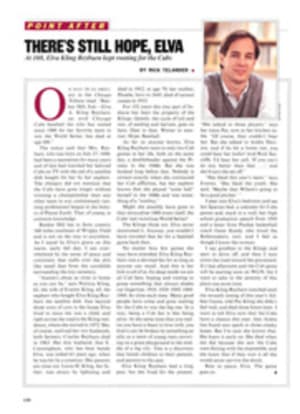
SCREWBALLS, ONE AND ALL
Necessity isn't always the mother of invention. Consider orange marshmallow peanuts. Consider whoopie cushions. And consider the oddballs that rolled into the Toy Fair, in New York City, last February: the Belly Ball, the Stress-ball, the Hedgehog Ball, the Fuzzy Koosh Ball, the Hand Jive ball, the Pogo Bal and the Glo Ball. Who needed them? Who asked for them? Yet there they were, hard—and sometimes soft—proof that something as pure as a sphere can be perverted a thousand ways.
This year's toy fair included balls with pleasing appendages, balls with agendas, balls with noxious smells and balls with nauseating textures. Take the Belly Ball, which is filled with a damp, foamy substance and has a balloonlike shell. And—here's the rub—it has a belly button. Why should a ball have a belly button? Well, why not? After all, there's a precedent for it with navel oranges—the fruit that makes you wonder what really goes on in orange groves.
So it is with the Belly Ball. By all appearances, the Belly Ball's navel is a true navel. If you probe further, you'll see that the navel is at the end of a tube that comes from inside the ball, suggesting that the ball was not manufactured but born of another Belly Ball.
Truth is, the Belly Ball is not a true ball. It has relatives in the balloon family. It was conceived when an empty balloon was filled with stuff that, when dry, looks like eraser lint. To hide the Belly Ball's mixed parentage, someone tucked in its tube and tried to pass it off as a real ball. Neat trick. If only the filling hadn't leaked out. If only someone hadn't drawn attention to the thing's belly button by naming it Belly Ball.
Invariably, perverse balls draw attention to their parents. Such is the case with the rare Hedgehog Ball and the ominously omnipresent Koosh Ball. Remember when the starship Enterprise on Star Trek began having trouble with Tribbles? The Tribbles, if you recall, were seductively fuzzy, round, invertebrate creatures you could—and wanted to—cuddle in your palm. Trouble was, the Tribbles multiplied like rabbits and overran the Enterprise. Not long after that, the Tribbles evidently came to earth and began mating with cheerleaders' pom-poms, Fuller Brush toilet scrubbers, the rubber bands wound around newspapers on suburban lawns, and those prickly, rubbery, unwelcoming welcome mats. That invasion resulted in at least two new lines of balls.
The Hedgehog Ball, a rubber ball with prickles, is clearly the child of a Tribble that dallied with a rubber welcome mat. Indeed, if you took a tiny welcome mat and balled it up into a wad the size of a Tribble, you would have a brother of the Hedgehog Ball. This ball, though, is not destined for a long life, because it lacks the key to the Tribble's survival: its pernicious cuddliness. The Hedgehog Ball, though cute from a distance, is painful to catch.
The real danger lies with the second descendant of the Tribbles—the Koosh Ball, which is as winsome as a Tribble but lacks the latter's fur. Instead, the Koosh Ball is a palm-sized pom-pom, made of thousands of tiny quivering tendrils that look like broken miniature rubber bands. The Koosh Ball's tag boasts that it has a "unique energy absorbent design"—in other words, it doesn't bounce—and that it is "a love-able, laughable ball that goes KOOSH¬¨¬®‚àö√ú when you catch it." (I've yet to hear a single ¬¨¬®‚àö√ú from my Koosh Ball.) What the tag neglects to mention is that the Koosh is the most prolific descendant of Tribbles.
Not two years after the Koosh Ball arrived, in 1988, it had fathered the Mondo¬¨¬®‚àö√ú Koosh¬¨¬®‚àö√ú Ball—a bigger version of the Koosh¬¨¬®‚àö√ú—and the Fuzzy(tm) Koosh¬¨¬®‚àö√ú, made of skinnier, softer tendrils. How did this happen? Koosh Ball tags encourage everyone to buy more than one Koosh. Undoubtedly, the makers of the ball want Kooshes to have ample opportunity to consort with one another. Indeed, the tag orders you to "Throw 'em. Catch 'em. Wear 'em, Wiggle 'em. Teach 'em tricks.... Hug 'em. Collect 'em," and—get this—"Share 'em with your friends." No mystery what's going on here.
But why? There's nothing that makes an oddball look more conventional and respectable than lots of offspring. Take the Nerf family. First-generation Nerfs were surely the result of the unlikely mating of a kitchen sponge with a baseball. That was 20 years ago. Nerfs have since become accepted, fully assimilated members of the society of balls. Nowadays, people play with, the Nerf as if it were the most natural thing around—as if it were as American as a baseball. The reason for this acceptance is that the Nerf now has descendants—Super Nerf, Nerf footballs, Nerf basketballs and Nerf soccer balls. The more generations there are of a bizarre ball, the less bizarre the original seems.
Every oddball strives for acceptance. If it isn't accepted, it won't make it. One of the telling marks of an upstart ball is unabashed self-promotion, which amounts in some cases to a kind of bossiness. These balls come with instructions that tell you how to play with them, lest you somehow miss the whole point of their existence. The odder a ball is, the more instructions it is likely to have.
Take the Stressball. Right away, you know this is a ball with a therapeutic mission. The box the ball comes in tells you that to relieve stress you should "throw yourself a harmless little tantrum" with the Stressball. Now honestly, who wants to play with a ball that orders you around before you've even taken it out of the box? But, for argument's sake, say that you are under a lot of stress. What are you going to do?
Follow the directions on the box. First, open it, and...what's this? More orders? Though the directions state that the Stressball can be thrown at anything, the ball comes with a "bunny tantrum target" for beginners ("bunny" as in the sort of slope favored by novice skiers), and it provides a "focus for your blind aggression." You're supposed to toss the Stressball at rings on the paper bunny target. They represent such loathsome people as "Your therapist, who just bought a classic 1932 Bentley," "Your stockbroker, who just bought a new Lamborghini," "Your mechanic, who can't hear the noise under the hood but says you need a new transmission," and so on.
If you can forget for a moment that someone connected with the Stressball has an acute case of automobile envy, it's time to "throw yourself a harmless little tantrum." Harmless? Throw a tantrum with this baby, and you're likely to wind up in shock therapy. The ball is a little too big to fit in one hand, a little too hard to squeeze and just similar enough to Styrofoam to make you anxious about the ozone layer. And that's not all.
Whether you throw the Stressball against the bunny-tantrum target or drop it on the ground, it lets out a clap of deafening static that's practically guaranteed to shatter the soundest psyche. The noise is supposed to remind you of "the sound 'of a plate glass window breaking." We all know how calming that is. On the other hand, if you're taking orders from a ball, you're pretty close to the edge anyway. If you were a little more clear-minded you would see that the Stressball is in no position to boast about its lineage. It is nothing more than a lowly descendant of fast-food containers, baseballs and static-ridden walkie-talkies, desperately struggling to become a real ball.
Snicker if you like. But the upstarts of today are the balls your children will play with tomorrow. Bear in mind that baseballs, basketballs, tennis balls and footballs were once oddballs looking for a little respect.
TWO ILLUSTRATIONS
LAURA CORNELL
Sarah Boxer, a New York-based free-lance writer, has written several stories for SI.

